Tamiya A6M5c Zero 52c
Presented for iModeler colleagues and friends, the Tamiya A6M5c Zero from 1983. Though the model is old, it is still quite good, in my opinion. After doing my N1K1 Shiden, I had an urge to do its contemporary, the late-war version of the famous Zero fighter. I had long ago done the Monogram A6M5 kit, which is from an era when Monogram did not know whether models were going to be toys or grown-up collectibles. The Monogram Zero is the early toy end of the spectrum, while the Tamiya kit is very grown up. I would not recommend anyone on this site to do the Monogram kit, except as a study of very early plastic models.
In the early 1980s, Tamiya started to distance itself from its competitors with their amazing color catalogs (very collectible in their own right), and with very good detailed kits for that time. This kit is a very worthwhile subject, and is representative of the excellence that emerged from high-end manufacturers of that time.
As with some other models, my appreciation for both the Mitsubishi and Tamiya product grew as I neared completion and could see this plane/replica from infinite angles. The Zero was an engineering marvel and is aesthetically very pleasing to the eye. My old Monogram (toy) did not capture the beauty of this airplane (mostly because their wing was too thick, and the detail too lacking). When accurately represented, this airplane is nearly as beautiful as an early Spitfire in many respects.
I really like the tight fit and high detail for its time, but surprisingly I had to carefully cut the decals, after they dried, to make the recessed panel lines become visible, plus a lot of setting solution over two days. The kit was bought at an IPMS Northern Virginia show and was in the stash for at least 10 years, so that likely contributed to my decal issue.
This model represents a 302 Kokutai plane stationed at Atsugi air base in August 1945, and is one of seven planes that can be finished with the kit-provided decals.
My 1974 Monogram Zero, with its 'Hawker-Hurricane-like' wing is also displayed in one of the pictures, mainly as tribute to Tamiya's excellence. It remains in my collection, and I believe it is my oldest kit. I refinished it in the early 1990s.
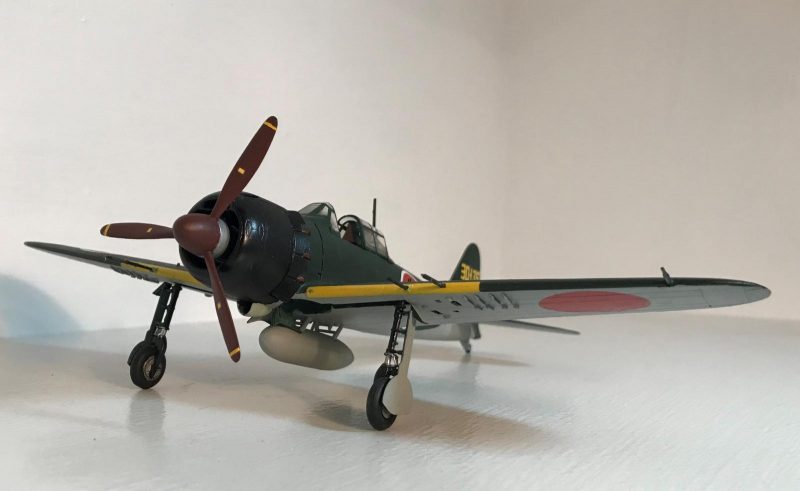
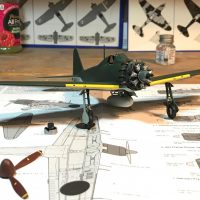
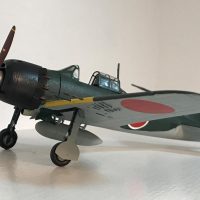
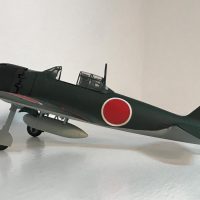
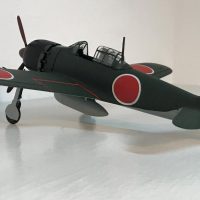
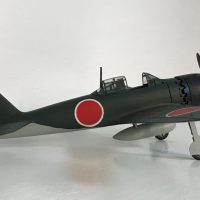
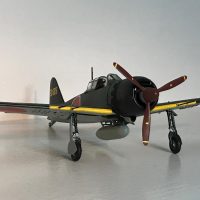
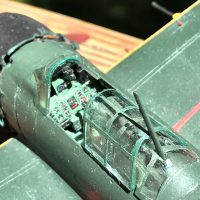
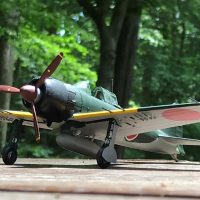

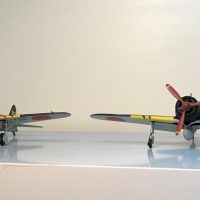
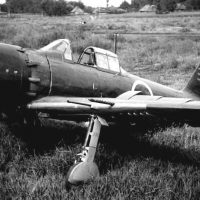

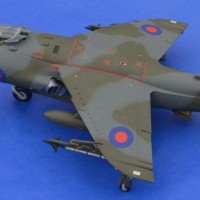

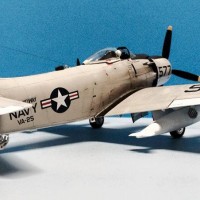
This is a wonderful Zero, my friend Bob!
It indeed captures the aesthetic lines of the original.
Loved reading your article, as well!
Many thanks for the kind comments, Spiros. Always great hearing from you, and I follow your comments on all the new posts.
Happy modeling!
The kit is actually older than you present. That line of Tamiya Zeros are from the mid-1970s. They do indeed represent the better end of what 70s-era technical knowledge of the subject and plastic molding production technology was capable of, and they can make a nice model. But it you stand them up against the Zeros Hasegawa started bringing out 20 years later, you can see the result of what more subject matter knowledge and production technology can produce. As the Tamiya kit is superior to the ancient Monogram, Hasegawa's kits are superior to the Tamiya, and are only beaten by the Tamiya releases that came along 20 years after Hasegawa, though the fact Tamiya only does two sub-types now - where they did all sub-types 45 years ago - still leaves Hasegawa the overall winner on points. The same is true of the Tamiya Ki-84 from the mid-70s when compared with the Hasegawa offering that came out 20 years ago. Fortunately for we modelers, time does bring more knowledge of the topic and better ability to design and produce a more accurate kit. All of which is not to say a nice model can't result from the older kits, as you demonstrate. But I sure take the new Dora Wings Bloch 152 and 155 over the Classic Airframes kits, the same way I take Eduard P-51Ds over the Tamiya kit from 27 years ago.
YMMV
Thanks for the thoughtful comments, Tom. Much appreciated. And yes, Tamiya evolved their Zeros from the previous year's model. The 1983 catalog has the A6M3, but the "5" was evidently not available when the catalog went to the presses. Hasegawa did surpass Tamiya's quality later on too, but this very passable kit was in the stash and ready to go.
I could only find a low quality pic of the back cover of their 1984 catalog, which features the A6M5c, and is posted to the photos section.
1 attached image. Click to enlarge.
1. 1984 Tamiya Back Cover featuring A6M5c
A beautiful build, Bob.
Reading your article sets this Tamiya kit high on my 'still to do' list.
Thanks for comments, John. If you already have one, it will be time well spent.
And as Tom Cleaver pointed out, the Hasegawa version is superb, and I saw there was a Taiho version on Ebay today (tail code "601-18" in yellow), which looks cool.
Very nice. Love the arboreal background! Yes, also the too small wheels on the Mono kit. Same issue with the 20th C Toys 1/32 Macchi.
Thanks, Ross. I re-painted an equally old Monogram TBF in Atlantic Fleet colors and bought after market wheels for it, since the kit tires were Tootsy Toy quality. It might be a bit crazy to invest in such an old kit, but I like to put my really old models through a "Depot Level Modernization".
Nice Zero!
Many thanks, Greg. It was a heck of a design from Jiro Horikoshi, and caused a lot of mayhem in its day.
I really like the look of your Zero, Bob. Amazing on the actual age of the kit.
The exhaust work of the A6M5 sure makes the Zeke look much more aggressive than earlier versions.
Nice post!
Many thanks, George. I like the hockey puck base on your movie 'Mig-28'. I guess the movie people didn't realize the Russians use odd numbers for fighter planes and even numbers for bomber/attack aircraft.
@bobd56az
hello! Nice zero! What paint do you used?
Hello Lis, and thanks for the question. My paints were Mr Color 383 (Kawanishi IJN Green), and then a thin coat of Floquil IJN green. Unfortunately Floquil paints were discontinued about 6 years ago, I believe.
Bottom camo was RAF SKY, Model Master 2049 and flat gull grey Model Master 1730 mixed at a 1:1 ratio. Sadly I see that Model Master is also discontinued (see link).
http://cs.finescale.com/fsm/general_discussion/f/9/t/184529.aspx
Awesome job. Was that cockpit OOB? Liked.
Hi, Doug. It is straight out of the box. I used green Zinc Chromate plus dark sea blue (both Model Master @ 3:1 ratio) and airbrushed it on. Then Future floor wax acrylic for the instrument panel and console, then the kit decals. The decals did not bend on the port side consoles, so I had to cut it with an xacto knife. I you do this kit out of the box, recommend cut the decals before applying, rather than trying to bend them -- that didn't work for me. Thankfully a careful cut plus more setting solution fixed it.
Happy modeling!